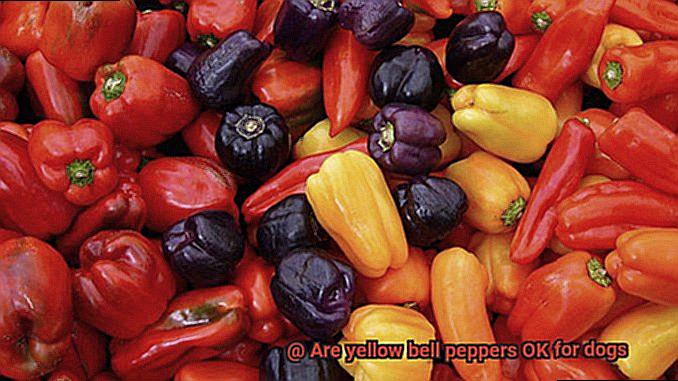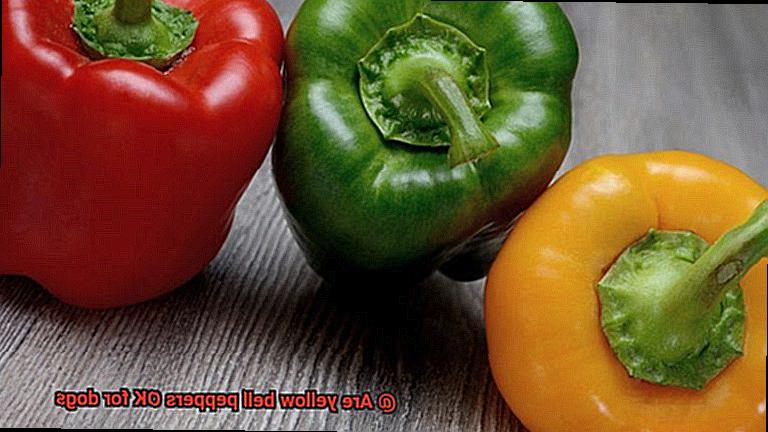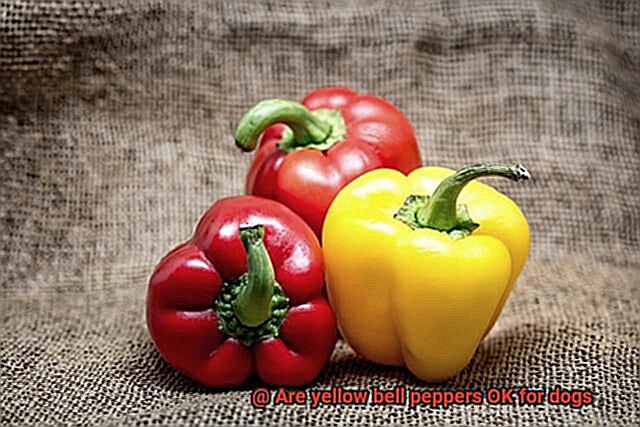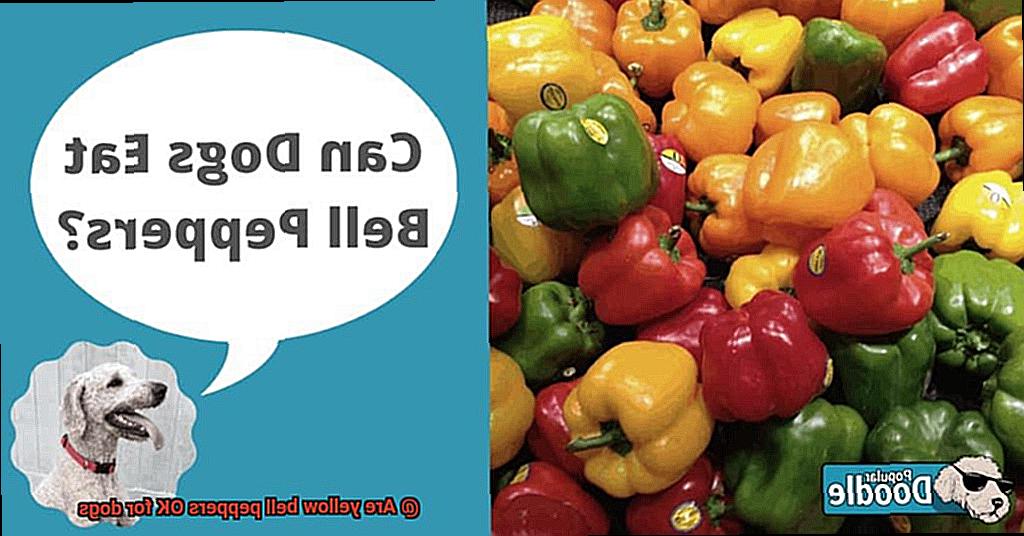Are yellow bell peppers OK for dogs?
As dog owners, we’re always on the hunt for healthy treats to keep our furry pals happy and thriving. While some human foods are a big no-no for our pups, others can actually be a nutritious addition to their diets. Today, we’re diving into the vibrant world of yellow bell peppers.
With their eye-catching color and satisfying crunch, you might be wondering if these sunny peppers are safe for your four-legged friend. Well, get ready for some good news. Yellow bell peppers can be a paw-some choice for dogs, packed with essential nutrients that offer a range of potential health benefits. But before you start dishing them out like there’s no tomorrow, it’s important to know about a few potential hazards and take some precautions.
In this blog post, we’ll explore the dos and don’ts of feeding yellow bell peppers to your dog. We’ll uncover the benefits they bring and the risks they may pose. So grab a seat, get comfy, and let’s dig into the colorful world of yellow bell peppers together.
What Nutrients Do Yellow Bell Peppers Contain?
Contents
- 1 What Nutrients Do Yellow Bell Peppers Contain?
- 2 How Much Vitamin C Is in Yellow Bell Peppers?
- 3 Are There Any Potential Health Risks for Dogs from Eating Yellow Bell Peppers?
- 4 How Should You Introduce Yellow Bell Peppers to Your Dog’s Diet?
- 5 What Preparation Steps Should You Take Before Feeding Your Dog Yellow Bell Peppers?
- 6 Are There Any Alternative Ways to Feed Your Dog Yellow Bell Peppers?
- 7 What Else Should You Consider When Adding Yellow Bell Peppers to Your Dog’s Diet?
- 8 Conclusion
Well, I’ve got good news for you – yellow bell peppers can be a healthy addition to your dog’s diet. However, there are a few things you should keep in mind.
First and foremost, it’s important to remember that dogs have different dietary requirements compared to humans. While yellow bell peppers are safe for us to consume, they may not agree with your four-legged companion’s sensitive tummy. That’s why it’s crucial to introduce any new food gradually and observe your dog for any adverse reactions.
Yellow bell peppers offer a variety of nutritional benefits for dogs. They are packed with vitamins and minerals that can support overall health and well-being. Let’s take a closer look at some of the key nutrients found in these colorful veggies:
- Vitamin C: Just like humans, dogs can benefit from the immune-boosting powers of vitamin C. This antioxidant vitamin helps protect cells from damage and supports a healthy immune system. So, sharing a slice of yellow bell pepper with your pup can give their immune system a little extra boost.
- Vitamin A: Vitamin A is essential for maintaining healthy vision in low light conditions. It also supports the immune system and helps promote the growth and development of cells and tissues. By adding yellow bell peppers to your dog’s diet, you can help support their eye health.
- Vitamin B6: This vitamin plays a crucial role in brain development and function. It aids in the production of neurotransmitters that regulate mood, sleep, and appetite. So, if your pup is feeling a bit down or struggling with their appetite, a bite of yellow bell pepper might just do the trick.
- Fiber: Just like humans, dogs need fiber to maintain a healthy digestive system. Fiber helps regulate bowel movements, prevents constipation, and supports a healthy gut microbiome. By adding yellow bell peppers to your dog’s diet, you can help keep their digestive system running smoothly.
- Potassium: This mineral is essential for maintaining proper heart function and regulating blood pressure. It also helps balance fluids in the body and supports muscle and nerve function. By sharing some yellow bell pepper with your pup, you’re providing them with a tasty source of potassium.
- Antioxidants: Yellow bell peppers are loaded with antioxidants, including carotenoids like beta-carotene. These antioxidants help neutralize harmful free radicals and protect cells from oxidative stress and damage. By incorporating yellow bell peppers into your dog’s diet, you’re giving them a delicious way to fight off those pesky free radicals.

How Much Vitamin C Is in Yellow Bell Peppers?

If you have a French Bulldog, you might be wondering if yellow bell peppers are a good source of vitamin C for your furry friend. Well, the good news is that yellow bell peppers do contain a high amount of vitamin C, which can be beneficial for dogs just like it is for humans.
Vitamin C is an essential nutrient that plays a crucial role in supporting the immune system, promoting healthy skin and coat, and overall health and vitality. While dogs are capable of producing their own vitamin C, certain factors like stress, illness, and aging can deplete their natural supply. This is where yellow bell peppers can come in handy.
On average, a medium-sized yellow bell pepper contains around 183 milligrams of vitamin C. This amount is well within the recommended daily intake of vitamin C for dogs, which typically ranges from 10 to 50 milligrams per kilogram of body weight. So, including yellow bell peppers in your French Bulldog’s diet can provide them with an additional source of this important nutrient.
However, it’s crucial to remember that excessive intake of vitamin C can lead to digestive upset in dogs. Therefore, it’s always best to consult with your veterinarian before making any significant changes to your dog’s diet.
In addition to vitamin C, yellow bell peppers also contain other beneficial nutrients such as fiber, folate, and antioxidants. These nutrients can contribute to your French Bulldog’s overall health and well-being when consumed as part of a balanced diet.

So, if you’re looking to give your French Bulldog a healthy boost, consider adding some yellow bell peppers to their meals. Just make sure to introduce them gradually into their diet and monitor their response. With the right amount, your furry friend can reap the benefits of this vitamin-rich veggie.
Remember, always consult with your veterinarian before making any changes to your dog’s diet or introducing new foods. Your vet will be able to provide you with personalized advice based on your French Bulldog’s specific needs.
Are There Any Potential Health Risks for Dogs from Eating Yellow Bell Peppers?
If you’re wondering whether your furry friend can munch on yellow bell peppers, you’ve come to the right place. As an expert in dog nutrition, I’m here to give you the lowdown on the potential health risks associated with feeding your French Bulldog these vibrant veggies.
Risk #1: Digestive Upset from Fibrous Skin
French Bulldogs, like many other dogs, may struggle to digest the fibrous skin of yellow bell peppers. This can result in tummy troubles or even intestinal blockages. To play it safe, remove the skin and seeds before serving bell peppers to your Frenchie. This will ensure easier digestion and minimize any potential risks.
Risk #2: Pesticide Exposure
We all want to keep our fur babies safe from harmful chemicals. When it comes to yellow bell peppers, there is a possibility of pesticide residue on the surface. Be sure to wash them thoroughly before offering them to your French Bulldog. Alternatively, consider buying organic bell peppers to reduce the risk of pesticide exposure.
Risk #3: Pre-existing Medical Conditions
French Bulldogs with certain medical conditions, such as pancreatitis or gastrointestinal sensitivities, may be more susceptible to digestive issues when consuming yellow bell peppers. It’s crucial to consult with your veterinarian before introducing any new food into your Frenchie’s diet, especially if they have pre-existing health concerns.
Moderation is Key
Remember, moderation is key when it comes to treating your French Bulldog with yellow bell peppers. Introducing large amounts of any new food can potentially upset their stomachs or lead to diarrhea. Start with small portions and observe how your Frenchie reacts before making bell peppers a regular part of their diet.
Keep an Eye Out for Allergic Reactions
Just like humans, dogs can have food allergies too. After feeding yellow bell peppers to your French Bulldog, be sure to monitor them for any signs of allergic reactions. If you notice symptoms like vomiting, diarrhea, or excessive drooling, discontinue feeding bell peppers and seek advice from your veterinarian.
How Should You Introduce Yellow Bell Peppers to Your Dog’s Diet?
If you’re wondering whether you can introduce some yellow bell peppers into your furry friend’s diet, you’ve come to the right place. As an expert in all things doggy nutrition, I’m here to give you the lowdown on how to safely incorporate these vibrant veggies into your pup’s meals.
First things first, it’s essential to take a gradual approach when introducing yellow bell peppers to your Frenchie’s diet. Start by offering small pieces of cooked bell pepper as a treat or mix it into their regular food. This way, your pup can get used to the new taste and texture without overwhelming their delicate digestive system.
Now, here’s a pro tip: before you serve those peppers up, make sure to remove the seeds, stem, and core. These parts can be tough for dogs to digest and may cause tummy troubles. And while we’re at it, peeling off the skin is also a good idea. It can be a bit tough and challenging for our little Frenchies to chew.
As with any new food, it’s crucial to keep an eye on your pup’s reaction. Look out for any signs of discomfort or digestive issues like vomiting or diarrhea. If you notice anything unusual, it’s best to stop feeding them the yellow bell peppers and give your vet a ring.
But hey, don’t let that scare you. Yellow bell peppers are packed with vitamin C and antioxidants, making them a healthy addition to your Frenchie’s diet. Just remember, moderation is key. While some Frenchies may handle these peppers like champs, others may have sensitivities or allergies. So always consult with your veterinarian before making any changes to your pup’s menu.
What Preparation Steps Should You Take Before Feeding Your Dog Yellow Bell Peppers?
Well, you’ve come to the right place. In this paw-some guide, we’ll walk you through the necessary preparation steps to ensure a safe and enjoyable culinary adventure for your precious pooch.
Step 1: Wash Away the Woes
First things first, let’s give those yellow bell peppers a good rinse. We all know how dirty those veggies can get, and the last thing we want is for our fur babies to ingest any harmful substances. So go ahead, grab your trusty veggie brush, and give those peppers a gentle scrub under running water. Voila. Fresh and clean.
Step 2: Seed-free is the Way to Be
Now that our peppers are squeaky clean, it’s time to remove the seeds and core. While the juicy flesh of yellow bell peppers is safe for our four-legged friends, those pesky seeds can be a bit hard to digest. So grab a knife or spoon and scoop out the insides, leaving only the deliciously sweet pepper pulp.
Step 3: Chop ‘Em Up
Time to get creative with your culinary skills. Grab a sharp knife and slice those yellow bell peppers into small, bite-sized pieces. This makes it easier for your little buddy to chew and digest without any risk of choking. Plus, it adds a delightful crunch to their dining experience.
Step 4: Test the Waters
Remember, every pup is unique, just like us humans. So it’s essential to introduce yellow bell peppers gradually into your dog’s diet. Start by offering small amounts and observe how your furry friend reacts. Keep an eye out for any tummy troubles or allergic reactions such as vomiting, diarrhea, or skin irritations. We want only tail wags and happy woofs.
Step 5: Vet Check
Before embarking on this yellow bell pepper adventure, it’s always a good idea to consult with your veterinarian. They know your pup’s health history better than anyone and can provide personalized advice based on their specific needs. Plus, they might even have some tasty treat recommendations to complement those peppers.
Conclusion:
There you have it, folks. The ultimate guide to preparing yellow bell peppers for your pup. By following these preparation steps and keeping a close eye on your furry friend, you can safely introduce this nutritious veggie into their diet. So go ahead, get cooking, and watch those tails wag with delight. Happy munching, everyone.
Are There Any Alternative Ways to Feed Your Dog Yellow Bell Peppers?
Don’t worry, there are alternative ways to incorporate the nutritional benefits of these vibrant veggies into your furry friend’s diet. In this article, we’ll explore some creative methods that will have your pup wagging their tail in delight.
Pureed Perfection:
If your four-legged companion prefers smooth textures, pureeing yellow bell peppers may be the perfect solution. Start by steaming or boiling the peppers until they become soft. Then, blend them into a smooth paste. This puree can be mixed with your dog’s regular food, ensuring they receive all the vitamins and minerals of yellow bell peppers without the need to chew on the actual pepper.
Tasty Homemade Treats:
Dehydrating yellow bell peppers can transform them into crispy and nutritious homemade dog treats. After removing the seeds and core, slice the peppers into thin strips and place them on a baking sheet. Bake at a low temperature until they become delightfully crispy. These treats can serve as a healthy snack or training reward for your Frenchie.
Crunchy Delights:
If your pup enjoys crunchier textures, thinly slice yellow bell peppers and bake them in the oven until they reach the desired crispiness. These homemade chips can be used as training treats or added to their regular meal for an extra burst of flavor and texture.
Incorporate in Homemade Dog Food:
Why not take it one step further and include yellow bell peppers in your homemade dog food recipes? By combining cooked yellow bell peppers with other dog-friendly ingredients like lean meats, vegetables, and grains, you can create a balanced meal that provides all the necessary nutrients for your furry friend’s well-being.
Moderation is Key:
While yellow bell peppers are a nutritious addition to your dog’s diet, they should not be the sole component of their meals. Remember to maintain a balanced diet that includes a variety of proteins, carbohydrates, healthy fats, and other essential nutrients.
What Else Should You Consider When Adding Yellow Bell Peppers to Your Dog’s Diet?
Yellow bell peppers are not only tasty but also pack a punch when it comes to nutrition. They are rich in vitamins A, C, and E, which are essential for your dog’s immune system and overall health. Antioxidants found in yellow bell peppers can also help fight off free radicals and reduce inflammation. Additionally, these peppers contain fiber, which aids in digestion and can help regulate your dog’s bowel movements.
Moderation
While yellow bell peppers offer many benefits, it is crucial to remember that moderation is key. Introduce small amounts of yellow bell peppers into your dog’s diet and observe how they react. If they tolerate it well, you can gradually increase the portion size. Too much of any new food can upset your dog’s stomach and potentially lead to gastrointestinal issues.
Allergies
Just like humans, dogs can have food allergies or sensitivities. Before adding yellow bell peppers to your pup’s diet, check if they have any known allergies to bell peppers or other similar foods. If your dog has shown adverse reactions in the past, it is best to consult with your veterinarian before introducing new foods.
Preparation
To make yellow bell peppers easier for your dog to digest, it is important to prepare them properly. Remove the stem, seeds, and membranes as these parts can be difficult for dogs to process. It is also recommended to cook the peppers before serving them to your dog. Cooking breaks down the cell walls and makes the nutrients more accessible and digestible.
Other Ingredients
Consider the overall balance of your dog’s diet before adding yellow bell peppers. If they already receive a variety of vegetables and fruits, adding yellow bell peppers may not be necessary. However, if their diet lacks variety or specific nutrients, yellow bell peppers can be a valuable addition.
Consult Your Veterinarian
Before making any significant changes to your dog’s diet, it is always best to consult with your veterinarian. They can provide personalized advice based on your dog’s specific dietary needs and health conditions.
KVx6DYU2E74″ >
Conclusion
In conclusion, yellow bell peppers can be a fantastic addition to your dog’s menu, offering a burst of health and vitality. These vibrant veggies are loaded with vital vitamins and minerals that can bolster your furry friend’s overall well-being. However, it’s crucial to introduce yellow bell peppers gradually and in moderation, as some dogs may have sensitivities or allergies.
Yellow bell peppers boast an impressive array of nutritional benefits that your dog will love. They’re packed with immune-boosting vitamin C, eye-nourishing vitamin A, brain-empowering vitamin B6, digestion-friendly fiber, heart-loving potassium, and powerful antioxidants that combat harmful free radicals.
When serving up yellow bell peppers to your pup, remember to remove the skin, seeds, and core. These parts can pose a challenge for their digestion system. Additionally, make sure to give the peppers a thorough wash to eliminate any lingering pesticide residue.
Before you embark on this culinary adventure with your four-legged companion, consult with your trusted veterinarian. They possess the expertise needed to provide personalized advice based on your dog’s unique requirements. Their guidance will ensure that yellow bell peppers are a safe choice for your furry friend.
Keep in mind that each dog has their own quirks and preferences when it comes to food. Therefore, it’s essential to keep a close eye on their reaction when introducing new treats. Should you notice any adverse effects like digestive discomfort or allergic reactions, immediately halt the yellow bell pepper feast and seek guidance from your veterinarian.
By adhering to these guidelines and considering your dog’s individual needs, you can confidently incorporate yellow bell peppers into their diet as a delightful and nutritious treat.




